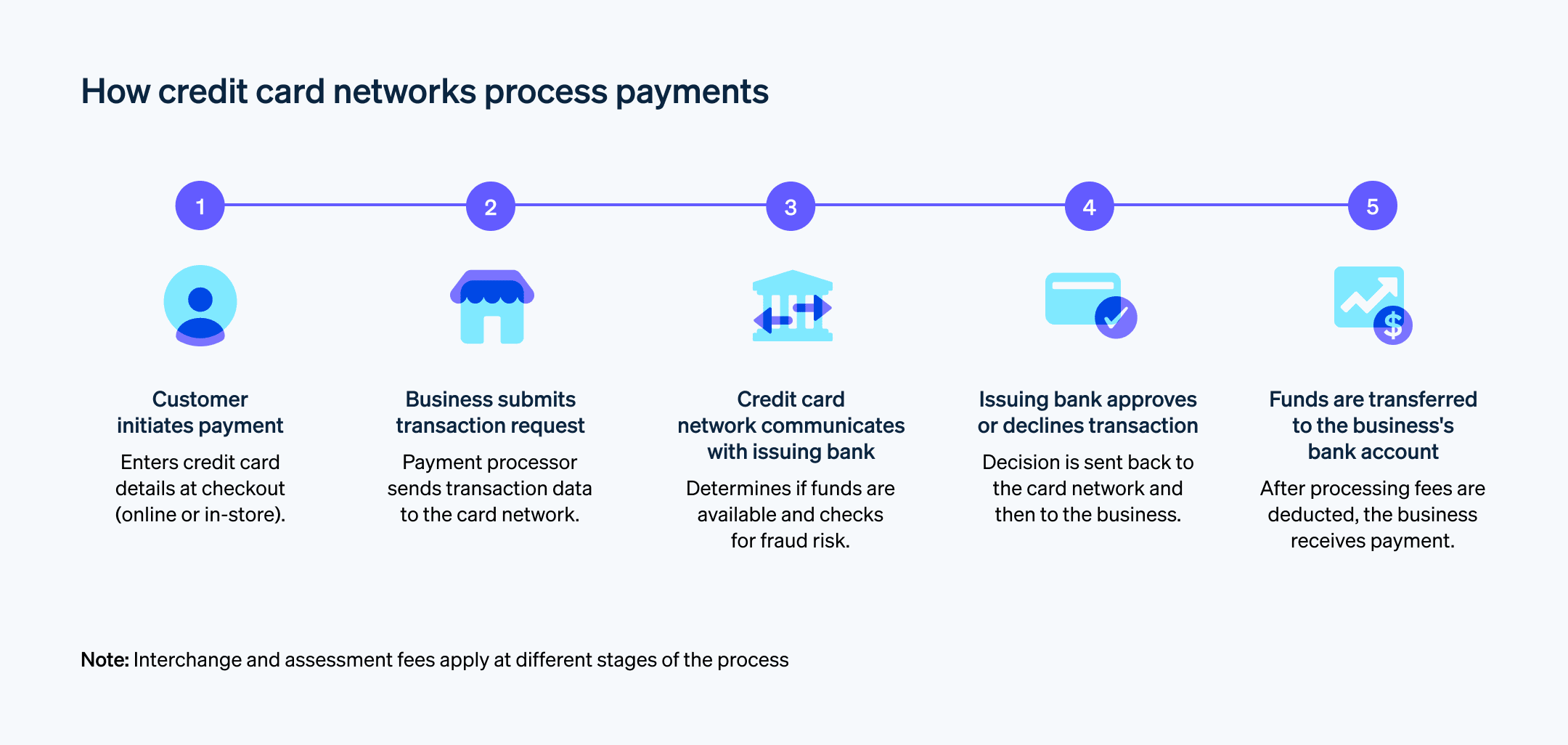信用卡是全球最受欢迎的支付方式,全球每天有 10 亿笔信用卡交易发生。小企业主经常与信用卡及其组织打交道,但许多人不知道信用卡组织的运作方式,并且默认接受客户想要使用的任何信用卡。
接受多种支付方式有助于开展业务,但了解信用卡组织的运作方式 可以让企业主深入了解如何最大限度地提高使用率并最大限度地降低风险。以下是企业应该知道的内容。
目录
- 什么是信用卡组织?
- 信用卡发卡机构与信用卡组织
- 信用卡组织的类型
- 开放式卡组织
- 封闭式卡组织
- 开放式卡组织
- 信用卡组织如何运作?
- 信用卡组织费用
- 信用卡交易有哪些类型的费用?
- 为什么 American Express 和 Discover 对企业收取更高的费用?
- 信用卡交易有哪些类型的费用?
- 为什么信用卡组织对企业很重要
什么是信用卡组织?
信用卡组织为发卡银行和企业提供用于处理信用卡交易的通信系统。信用卡组织和发卡行授权和处理信用卡交易,设置交易条款,并在客户、企业及其银行之间转移付款。主要的信用卡组织包括 Visa、Mastercard、American Express 和 Discover,但还有其他卡组织。
信用卡发卡机构与信用卡组织
信用卡发卡机构或发卡银行是向人们提供信用卡的金融机构。例如,如果您通过您的主要银行机构获得了一张信用卡,上面有其徽标和 Visa 徽标,则该银行是信用卡发卡机构,而 Visa 是信用卡组织。
当您使用信用卡购物时,交易请求会转到信用卡发卡机构,然后由发卡机构决定是否对其进行授权。发卡机构是向持卡人提供信贷的机构,持卡人向发卡机构偿还使用信用卡进行消费而欠下的债务。
信用卡组织也可以是信用卡发卡机构,这意味着它们向持卡人提供信贷,而不需要第三方金融机构作为发卡机构。
信用卡组织的类型
信用卡组织有两种类型 — 开放式和封闭式 — 它们对发卡的处理方式有所不同。
开放式卡组织
开放式信用卡组织允许其他金融机构向客户发行信用卡。
两个最大的开放式信用卡组织是:
- 维萨 (Visa)
- 万事达卡 (Mastercard)
封闭式卡组织
在封闭式信用卡组织中,信用卡公司专门发卡。信用卡组织还扮演着收单机构的角色,将资金直接支付给企业的银行,减去交易费用。
封闭式信用卡组织包括:
- 美国运通 (American Express)
- Discover
- 部分店铺发行的信用卡
信用卡组织如何运作?
信用卡组织的运作方式是连接信用卡购物所涉及的两方:发卡机构和企业。
1.客户发起付款
首先,客户通过向商家的销售点 (POS) 终端、读卡器或在线结账提交信用卡来发起交易。他们可以手动输入信用卡号、刷卡、插入卡的 EMV 芯片,或通过轻触卡片来启用卡或移动设备的非接触式支付机制。
并非每个企业都接受来自每个信用卡组织的付款。Stripe 支持全球所有主要信用卡组织以及较小的区域性卡组织。
2.商家的支付终端与信用卡组织连接
一旦卡信息被传输到企业的支付终端,支付处理商就会联系信用卡组织,请求批准交易。
如果卡组织同时是发卡行
如果客户的信用卡组织也发行了信用卡,则卡组织将决定是否批准该交易。如果卡组织没有发卡
如果信用卡有单独的发卡行,则卡组织会与发卡行协商,以确定是否应批准该交易。
3.卡组织会通知商家交易是被批准还是被拒绝
信用卡组织可以非常迅速地将决策返回给企业,通常只需几秒钟。

信用卡组织费用
信用卡组织对每笔交易收取不同的手续费。费用通常是企业在决定接受哪些信用卡组织时考虑的最重要因素。
信用卡交易有哪些类型的费用?
企业在每笔信用卡交易中支付的费用主要有两种类型:交换费和评估费。
交换费
发行信用卡的金融机构收取交换费。例如,如果富国银行发行了客户的万事达卡,则每当客户使用该卡进行购买时,企业都会向富国银行支付交换费。评估费
企业还向信用卡组织支付评估费。在富国银行发行的同一张万事达卡上,每次购物的评估费都归万事达卡所有。
借记卡通常对企业来说更便宜,但定价方式完全不同。
为什么 American Express 和 Discover 对企业收取更高的费用?
American Express 和 Discover 既是其信用卡的卡组织,又是其信用卡的发卡行,这会导致更高的费用 — 它们为每笔交易处理更多的工作量。这两个卡组织通过保留每笔交易的交换费和评估费而受益,但其较高的费用意味着一些零售商不接受他们的信用卡。
为什么信用卡组织对企业很重要
信用卡组织及其运作方式对企业有着巨大的影响,选择接受哪种类型的信用卡是一个重要决定。您的客户可能更青睐某些信用卡而不是其他信用卡,具体取决于您在哪里开展业务、您的客户是谁以及他们进行的购买类型。主要信用卡组织如何看待您的特定业务将反映在其费用结构中。
在决定接受哪些信用卡组织作为支付选项时,需要考虑以下几点:
地理
许多信用卡组织在全球范围内运营,而其他信用卡组织则仅限于某些国家/地区。在设置支付系统时,请确保接受您所在地区和您有客户的任何国际地区流行的信用卡组织。
例如,美国企业可能从未听说过银联,但该信用卡组织占中国银行卡支付的 93% 和全球银行卡支付的 45%。银联仅次于 Visa,管理的交易比万事达卡都多。忽视接受银联可能是一个巨大的疏忽,这取决于您的客户在哪里。
交换费
主要信用卡组织的平均交易费用占费率的大部分,但其他信用卡组织中也可能相差很大。每个卡组织在确定向任何给定企业收取的费率时都会检查多个因素,并且费率可能会发生变化。以下是信用卡组织在决定收取什么费用时考虑的主要因素:
卡的类型
作为消费者和企业,您可能在市场上遇到过大量的信用卡。即使同一个信用卡组织也可能提供数十种不同的卡,每种卡都提供不同的福利或针对特定的客户群。同一卡组织内不同类型的卡可能会产生不同的交换费用。
付款处理方法
交换费也因销售点处理信用卡付款的方式而异。这些处理方法包括:
- 使用近场技术 (NFC) 的感应式支付
- 插入 EMV(Europay、Mastercard 和 Visa)芯片卡
- 使用信用卡磁条(磁条)刷卡交易
- 无卡 (CNP) 交易
由于每种支付处理方法相关的欺诈和拒付风险不均等,交换费用也各不相同。例如,CNP 交易的安全性最差,因而往往具有更高的交换费用。
商家类别
每个接受信用卡付款的商家都会被分配一个商家类别代码 (MCC)。不同类别的企业适用不同的交换费。
本文中的内容仅供一般信息和教育目的,不应被解释为法律或税务建议。Stripe 不保证或担保文章中信息的准确性、完整性、充分性或时效性。您应该寻求在您的司法管辖区获得执业许可的合格律师或会计师的建议,以就您的特定情况提供建议。